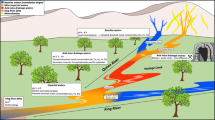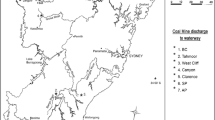Abstract
A detailed hydrochemical investigation has been undertaken to establish whether mining has adversely affected streams in the Tarkwa gold-mining district and, if so, to what extent. The results show that streams that pass through mining areas and receive mine water exhibit significant spatial and temporal variations in their major ion hydrochemistry. Water analyses of perceived pristine areas reveal that the study area has undergone silicate weathering, but in mining areas, carbonate weathering was inferred. The inconsistency is attributed to the chemistry of mine waters discharging into receiving streams. This is supported by the average pH values of 6.48 for pristine streams and 7.74 for those affected by mine water. Trace element analysis did not show significant changes from the norm except for discharges from a spoil heap, which exhibited hydrochemical characteristics consistent with acid mine drainage. Saturation indices determined for the water samples reflect the sandstone–quartzite–phyllite lithology and intense weathering regime of the area as a result of the humid tropical climate.
Résumé
Une étude hydrochimique détaillée a été réalisée pour savoir si les opérations minières avaient pollué les cours d’eau du district minier aurifère de Tarkwa, et si oui de quelle façon. Les résultats de l’étude montrent que les cours d’eau qui traversent les secteurs d’exploitation et reçoivent des eaux minières présentent des minéralisations significativement variables le long de leurs parcours ainsi qu’au cours du temps. Les analyses d’eau de zones reconnues comme non affectées par l’exploitation minière montrent des altérations silicatées alors que des altérations carbonatées sont reconnues dans les zones minières. L’explication de ces résultats réside dans la composition chimique des eaux minières rejoignant les cours d’eau. En effet la valeur moyenne de pH est de 6,5 pour les cours d’eau non affectés par l’exploitation minière et de 7,7 pour ceux qui sont affectés par les eaux de mine. L’analyse des éléments trace n’a pas montré de variations particulières sauf pour des eaux issues d’une verse à stériles qui présentaient des caractéristiques hydrochimiques témoignant du processus de drainage acide minier. Les indices de saturation déterminés sur les échantillons d’eau rendent compte du contexte géologique où sont présents des grès, des quartzites et des phyllites ainsi que du cadre climatique tropical humide.














Similar content being viewed by others
References
Acquah PC (1992) Emerging trends in gold ore processing and some related environmental issues in Ghana. In: Peters JW, Kesse GO, Acquah PC (eds) Regional trends in African geology. Proceedings of the 9th International Geological Conference, Accra, 2–7th November 1992. Geological Society of Africa
Akabzaar TM (2000) Boom and dislocation: the environmental and social impacts of mining in the Wassa west district of Ghana. Third World Network: Africa, Ghana
Ball JW, Nordstrom DK (1991) Users manual for WATEQ4F, with revised thermodynamic database and test cases for calculating speciation of major, trace, and redox elements in natural waters. US Geological Survey Open File Report 91-183. Menlo Park, CA, USA
Banks D, Younger PL, Arnesen RT, Iversen ER, Banks SB (1997) Mine-water chemistry: the good, the bad and the ugly. Environ Geol 32(3):157–74
Bowell RJ, Warren A, Minjera HA, Kimaro N (1995) Environmental impacts of former gold mining on the Orangi river, Serengeti NP, Tanzania. Biogeochemistry 28:131–160
Davis SN, Dewiest RJM (1991) Hydrogeology, reprint edn. Krieger Publishing Company, Florida, USA
Dickson KB, Benneh G (1988) A new geography of Ghana. Longman, London, UK
Dzigbodi-Adzimah K (1996) Environmental concerns of Ghana’s gold booms: past present and future. Ghana Mining J 2(1):21–26
Edmunds WM, Smedley PL (1996) Groundwater geochemistry and health: an overview. In: Fuge JD, McCall GJH (eds) Environmental geochemistry and health. Geol Soc Spec Publ 113:91–105
Eisenlohr BN, Hirdes W (1992) The structural development of the Early Proterozoic Birimian and Tarkwaian rocks in southwest Ghana, West Africa. J Afr Earth Sci 14:313–325
Farrell TP, Kratzing DC (1996) Environmental effects. In: University of New South Wales, Environmental management in the Australian minerals and mining industries. University of New South Wales, pp 14–45
Hem JD (1992) Study and interpretation of the chemical characteristics of natural water. US Geological Survey Water-Supply Paper 2254
Hirdes W, Nunoo B (1994) The Proterozoic paleoplacers at Tarkwa Gold Mine, SW Ghana: sedimentology, mineralogy and precise age dating of the main reef and west reef, and bearing of the investigations on source area aspects. BGR Geol Jb, D100, Hannover
Hounslow AW (1995) Water quality data; analysis and interpretation. Lewis Publishers, New York
Junner NR (1935) Gold in the Gold Coast. Gold Coast Geol Surv Mem 4
Junner NR, Hirst T, Service H (1942) The Tarkwa Goldfield. Gold Coast Geol Surv Mem 6
Kesse GO (1985) The mineral and rock resources of Ghana. Balkema, Rotterdam
Kortatsi BK (2000) The impact of mining on groundwater quality in the Tarkwa area, Ghana. In Sililo O (ed) Groundwater: past achievements and future challenges. Proceedings of the XXX IAH Congress on Groundwater, Cape Town, South Africa, 26 November to 1 December 2000
Kuma JS (2004) Is groundwater in the Tarkwa gold mining district of Ghana potable? J Environ Geol 45:391–400
Piper AM (1944) A graphic procedure in the geochemical interpretation of water analysis. Am Geophys Union Trans 25:914–923
Sraku-Lartey K (1993) Production and economic trends in the minerals industry in Ghana. In: Tsidzi KEN (ed) Proceedings of the National Seminar on Current Developments in the Minerals Industry of Ghana. 6–7 May 1993, Kumasi, Ghana
Whitelaw OAL (1929) Geological and mining features of the Tarkwa–Aboso Goldfield. Gold Coast Geol Surv Mem 1
Younger PL (1994) Low-cost groundwater quality investigation methods: an example from the Bolivian Altiplano. In: Nash H, McCall GJH (eds) Groundwater quality. Chapman and Hall, London, pp 55–64
Younger PL (1995) Hydrogeochemistry of mine waters flowing from abandoned coal workings in County Durham. Q J Eng Geol 28:S101–S113
Younger PL (2000) Holistic remedial strategies for short- and long-term water pollution from abandoned mines. Trans Inst Mineral Metall (Sect A: Mineral Technol) 109:A210–218
Author information
Authors and Affiliations
Corresponding author
Rights and permissions
About this article
Cite this article
Kuma, J.S., Younger, P.L. Water quality trends in the Tarkwa gold-mining district, Ghana. Bull Eng Geol Environ 63, 119–132 (2004). https://doi.org/10.1007/s10064-004-0227-8
Received:
Accepted:
Published:
Issue Date:
DOI: https://doi.org/10.1007/s10064-004-0227-8




